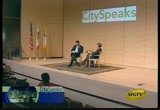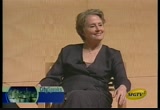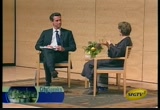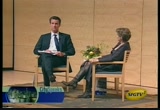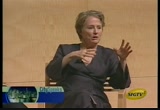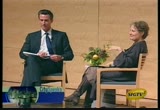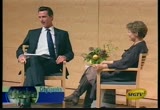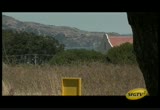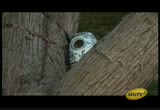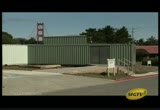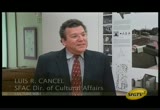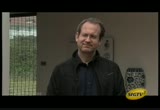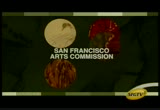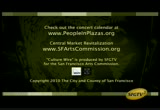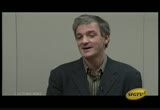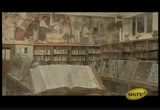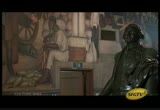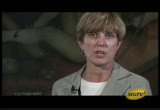tv [untitled] September 5, 2010 9:00pm-9:30pm PST
10:00 pm
states just saying, hey, please help us. help us. help us make this change. >> couple of questions about private funders. has the private and foundations gravitated beyond your foundation, is this an easy sell? >> what we have to do is make these models and make them really good. that is what has happened with the schoolyard. we put a lot of money into one. we have one in new orleans. it is amazing. this has been an idea, not a berkeley or san francisco idea, something that requires a kind of special fill anthropi and
10:01 pm
what better way to buy food than people that need money in that city? so the farmer's market is helping to supply the school. now the kids are going out into the neighborhood and picking up cans and bottles and examing them, recycling them, making them into art work. it is a beautiful project. and it is a universal idea, as i say, it is not something that we dreamed up. this is the way people have been living since the beginning, buying things from local people. eating them together with the
10:02 pm
family and friends. we are just coming back to our senses. >> we have talked so much about children l. the question is, what is the best way to reach adults that have fast food ingrained into their system? thoseover those of us that know. >> planting the perfect ripe peach. i thought if he just could taste this. >> president clinton in terms of fast food addiction. [laughter]. >> once you taste you can't go back. it is very, very -- it is not just the taste. it is the care that comes with
10:03 pm
the taste. see you feel this. it is a lot of non verbal kindsover longings that i think a lot of people have. and then we need to connect up with that. sitting at a table and eating garlicy foods. it works in some beautiful way. you go to italy and you see that really translated into the culture. that is why that movement is so strong and why they are so successful in combatting the globalization of food. in other countries like france, they are just opening the doors. >> most of the best practice, most what you see happening,
10:04 pm
that by way of example is happening outside the united states. any other parts of this country and region? now you are talking about peaches and things. >> we have a good friend up in maine. he has a green house. a very kind of organic and affordable green house situation. he grows them and closes in the summer. he is growing salads. we had to learn to eat differently at different times of the year. when we were doing this project
10:05 pm
at yale, what are we going to eat for 9 months out of the year? we found all kinds of dried beans, dried fruits. we found vegetables, all of the beautiful heirloomed potatoes and made syrups. we ate fish. we used to know how to do this. nobody knows how to cook, true? so when we teach this course in school, one of the outcomes is everyone is going to learn how to cook and farm. it is going to be a beautiful outcome of this core curriculum
10:06 pm
in ego gastronomy. edible education. sounds a little too gastric. it really says what it is. it is a huge, beautiful subject that we need to be studying. >> are people teaching this stuff? new york university? >> slow food university. >> there is actual slow food university? >> university of the gastroano, ma'amic sciences. they send students around the world to intern. >> is berkeley teaching any of these things? god for bid, stanford? [laughter]. >> all of the forestry programs. i mean, definitely, we have
10:07 pm
michael pollen at new york university. we have marian nesum. kelly brown teaching psychology. we have to connect in a way. we sort of imagine this event moving around the country. we'll continue to always have something in san francisco. we want to go to chicago, new york, and new orleans and really bring people to experience different parts of the country to pull us together of a slow food nation. >> because of time, i want to wrap this up. we don't have time to talk about the work you have done in
10:08 pm
edible schoolyards in new orleans. the slow food nation is going to happen in san francisco this labor weekend. how can people get involved, not only slow food nation, but with also get involved in this whole movement? i want to learn more, i have to know more. is there a book you recommend? a website? a brochure we can pick up or a phone number? >> we do have a brochure. there are lots of brochures. certainly the website of slow food nation is a way to get connected and understand what is happening in international movement.
10:09 pm
that is what is most important. this isn't just the united states. this is an international organization in 131 countries. we are having this conversation around the world and that is what needs to happen. we need to unite in that way. there are all kinds of incredible books. fast food nation is no. 1 homework piece. michael pollen's books bring us into the big picture around food. of course my own books. but we have to really think about what we are eating everyday. really pay attention to this. and thank goodness we have
10:10 pm
farmer's markets within 15, 20 minutes. >> i live in san francisco. >> i love organization like the people's groceries, taking food that is left from the farmer's market and taking it down to the poor sections of town and offering it. we need a big wholesale farmer's market in san francisco. >> we need to be able to have a place that gathers food that we can distribute it to the schools and hospitals and institutions around san francisco. so i think that funded by the city. it has to be affordable. >> you didn't hear my budget speech today. [laughter]. if people want to contact you
10:11 pm
and support the foundation? >> that is how they can, they can look up the website. and send their very big checks. we are trying to make the models, paying teachers to breathe life into this idea. that is what is going to make it convincing for the powers to be. >> it is dinner time. i hope you are going to think wisely tonight. i want to thank becca proda and thank you all very much, ladies and gentlemen, a big round of applause. [applause]. >> thanks, gavin. [applause].
10:13 pm
oil. thank you. we can go into a refinery and we can use it again. they do oil changes and sell it anyway, so now they know when a ticket to a. hal>> to you have something you want to get rid of? >> why throw it away when you can reuse it? >> it can be filtered out and used for other products. >> [speaking spanish] >> it is going to be a good thing for us to take used motor
10:14 pm
oil from customers. we have a 75-gallon tank that we used and we have someone take it from here to recycle. >> so far, we have 35 people. we have collected 78 gallons, if not more. these are other locations that you can go. it is absolutely free. you just need to have the location open. you are set to go.
10:15 pm
10:16 pm
a treasure within san francisco, because the presidio trust is really a national park in the center of an urban setting. it dates to the very founding of the city. national park. toting me today to talk about this amazing exhibition at presidio habitat is cheryl hanes. can you tell me a little bit about the idea of the presidio habitat? >> succinctly, i have been long involved in the presidio.
10:17 pm
i was here when it was still a military base in the 1980's. i remember driving down walmart to the golden gate bridge and seeing the military guard at the gate and being utterly fascinated. >> so presidio habitat is an exhibition where you have invited, how many artists to think about the habitat? >> we put together a list of possible participants, local, national, or international, of people who are concerned with environmental concerns, made some sort of contribution to the landscape and conversation we're having here. we said that broke -- proposal requests and we received 25 back. from that 25, we went through and chose tend to realize in the
10:18 pm
landscape. >> including this building, which is an amazing example of recycling. >> we are proud of this space. it was designed by a local architecture team. we said, we need something that is a temporary structure, something that can be brought onto the presidio in pieces, act as an exhibition space for one year. we came up with the notion of shipping containers. it was important for us that we made this project for the place, of the place. what i mean by that is participants would also used repurchased materials. >> we will be speaking to one of the artists that you selected. what excited you about his idea? >> have many things.
10:19 pm
first of all, i am a fan of his architecture. because of that creativity, i knew that he could come up with something unique. i love the fact that he was specifically addressing the landscape around here, and it was also about the human interaction with this place. >> what are your expectations with the people coming to presidio habitat? >> we really hope people will come with their family, dogs, and come back a number of times the works will change over the year. the feedback we are getting is you cannot do all of them on one visit. it is really better to come back and have different experiences. >> thank you. i am with mark jensen of jensen
10:20 pm
architect. he was one of the architects to be chosen to do the presidio habitat. when you heard about this project, what inspired you about that call? >> our inspiration is a great blue heron. it was the site itself that attracted us. this is an incredibly beautiful outdoor room. we did a bit of reverse engineering once we knew we wanted to work here. which animals live here? the great blue heron jumped out at us. we walked around, and quickly, you get into another pace. you slow down, leave the city behind you. you can feel the wind and the breeze. in our increasingly frenetic,
10:21 pm
fast-paced, connected life, the chance to be of here and slow down a bit was part of the agenda. as part of the installation, it was suggested that this would be deliberately not mowed because it would allow the sustaining of insects, plants, that would graduate -- that would gravitate to the area. >> that is right. i think you quickly notice that. >> thank you for being here. presidio habitat is an exhibition at the presidio trust. it will be in san francisco through may 2011. we hope you will come out to experience this amazing exhibition and great natural treasure. >> to learn more about the other habitats installations in the presidio, visit
10:22 pm
>> welcome to "culture wire." i'm your host meg. for years, free jazz concerts have been providing entertainment in downtown san francisco. people pay local musicians to perform for lunchtime crowds. the goal is not just entertainth. people in plazas are trying to create neighborhoods. what began as a forum for performers who were paid by passing the hat has become a program that provides wide exposure and more than 500 paid gigs annually for local musicians. from july through september, people in plazas produces almost 300 free performances in the
10:23 pm
lunchtime hour. the mission of people in plazas generates social congregation. and by having these events, we encourage people to make these plazas everybody's neighborhood. >> recently, the san francisco arts commission was awarded a $ 250,000 grant for the national endowment for the arts. to establish an arts district in the central market corridor between fifth and 10th street. throughout the yearing the arts commission will partner with people in plazas to activate the sidewalks along this stretch with art installation, opening events, live music, and new arts and antique markets at u.n. plaza. >> this area has been sleighted for many years, at least the past 25 years. i think that this redevelopment
10:24 pm
project and the n.e.a. grant are very positive signs that we have political will and a lot of momentum to really make the mid market area what it could be, which is a vibrant area where everybody is welcome and it's a place to be in san francisco. >> to get a feel for the future of the central market arts and culture district, be sure to catch out an upcoming concert. for locations and times, visit peopleinplazas.org. to learn more about the central market revitalization initiative, visit sfartcommission.org. thank you for watching "culture wire." >> many people are not awf this building was built in 1936. as a board to preserve the history and make the students aware of that history.
10:25 pm
the partnering between sfmoma and the arts commission means they will be more aware of the artwork that we have here, the artists that painted a, and the history behind this itself. >> students came from george washington, and it was wonderful to have them on a panel. people from the school board, those who have been painting for years, some conservative errors from the getty. to have them tell us about the works of their school was important. it represents african-american artists to during the 20's and 30's used an incredible body of work. it is one of the most incredible works of art in the city, bar none.
10:26 pm
it is a huge mural of incredible works. >> the san francisco civic arts collection has been in existence since the turn of the century. it consists of everything from monument to golden gate park to market street, other works in the collection, from the wpa era, the quite tower, the works from the george washington high school. we have the contemporary education, where they depict some of the vocational arts that were taught at george washington high school. what is interesting is the artist's and corp. of some of the -- incorporation of some of the architectural elements. they used the speaker from the p a system as part of the design. on the opposite side of the library, we have a large fresco which depicts the academic
10:27 pm
subjects that were taught at the time. it serves as a foil to the other fresco in the library, we have academic subjects on one side, vocational subjects on the other, and result is the concept of a well-rounded education. additionally, what we plan to do is the academy of hospitality and tourism will be part of, so the students can share with other students, faculty, the neighborhood, and others to come by and what to look to the artwork we have. >> by working with the students, we hope to raise awareness of the collection and foster stewardship. we brought diego rivera to the
10:28 pm
city. i think the wpa art work is characterized by stylized robustness and a pervasive occupation with a historical. in this panel, we have a depiction of george washington moving west. what is interesting about it is the image of lewis and clark here is in black and white, something that is occurring in the future, painted as though it was in the past. what is interesting about it is the very obvious conclusion of slavery. the number of students were expressing unease around some of the themes. the additional mural would be placed in the school, one with more positive representation of the student body. in 1974, they completed three
10:29 pm
panels that were placed in the library -- in the lobby. they depict native, latino, asian american, and african- american heritage and culture. >> that artist was talking about the history coming alive. that is what we want for the students here. i also think they might share that with past alumni and the community, so they could no the treasure that we have here in the schools. many people have the same experience i did when i first walked into this building three years ago, being the new principal. the grandeur of these murals is fantastic. many of the students who have come here have come here and are very proud of these murals. they're so happy that they're still here and are being preserved. >>
67 Views
IN COLLECTIONS
SFGTV2: San Francisco Government Television Television Archive
Television Archive  Television Archive News Search Service
Television Archive News Search Service 
Uploaded by TV Archive on

 Live Music Archive
Live Music Archive Librivox Free Audio
Librivox Free Audio Metropolitan Museum
Metropolitan Museum Cleveland Museum of Art
Cleveland Museum of Art Internet Arcade
Internet Arcade Console Living Room
Console Living Room Books to Borrow
Books to Borrow Open Library
Open Library TV News
TV News Understanding 9/11
Understanding 9/11